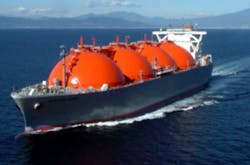3-D scanner scopes out ship’s engine room
Global maritime and offshore oil and gas engineering company Harris Pye (Barry, South Wales, UK) has used a 360 degree 3-D scanner to survey the engine room of a liquefied natural gas (LNG) carrying vessel to ascertain the best system for a ballast water treatment installation.
The vessel -- known as the Neva River -- is the LNG carrier of "K" Line LNG Shipping (UK) Limited (London, UK), which is part of the "K" Line Group, a shipping company that transports liquefied natural gas (LNG) all over the world.
The scan enabled Harris Pye engineers to rapidly create 3-D images of the entire engine room, and thus create various ballast water treatment models to select the best one. The entire engine room survey took less than five hours, causing minimal disturbance to the crew.
The scan gathered point cloud data which was then processed by Harris Pye’s Naval Architecture team through Autodesk’s (San Rafael, CA, USA) AutoCAD to create multiple walkthrough 3-D models from the scans.
“By being able to create walkthrough 3-D models for our clients, we can save them time and money, because the modeling allows us to test different options with absolute accuracy. It negates all the usual time-consuming survey and design work. And when the best solution has been selected, we know with absolutely certainty that the equipment will fit perfectly, down to the last bolt,” adds Harris Pye’s New Products Technical Manager, Ben Wise.
Harris Pye also uses Autodesk’s Inventor Professional isometrics and Integraph’s (Houston, TX, USA) CADWorx P&ID Professional for process diagram generation. Thermal stress analysis and flow design is performed using Integraph’s Caesar II, and Bentley’s (Huntsville, AL, USA) Staad.pro is used to undertake structural stress analysis.
The software combination gives Harris Pye the ability to accurately model pipe and steel work, clash-detect new modeled parts and optimize the design.
-- by Dave Wilson, Senior Editor, Vision Systems Design
